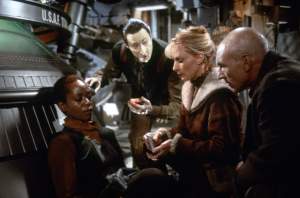Chutes and Ladders

colematt/istock
Like Candy Land, Chutes and Ladders is often one of the first board games that a young person might encounter, though the (pardon the pun) latter is infinitely more fun. The Milton Bradley classic is based on an ancient Indian game and is also known as Snakes and Ladders in non-American markets. While there isn’t much skill to the game, something is thrilling about the emotional rollercoaster a journey to the top of the board will take players on. That moment when the person who was assured of victory finds themself sliding back to square one always gets plenty of laughs around the table.
The Game of Life

YouTube
While the modern, recognizable version of The Game of Life was first published in 1960, the game traces its roots in the parlors of the late 19th century. The board has certainly evolved, but the silly fun of following your “life” via the game board from birth to school, to work, and on to retirement has remained the same at least in spirit.
The charm of the modern versions, with their small game-piece cars that collect “pegs” representing your growing family, are as nostalgic as the game show style spinner you use instead of dice.
Parcheesi

laura_uadjet/istock
Parcheesi is another game that can trace its roots back to ancient India. The game uses a classic “cross and circle” design, and while it is similar in many ways to games like Sorry, Trouble, Ludo, and others, there’s something about Parcheesi’s classic, reserved presentation, with its wooden dowel pieces and hard cardboard dice rolling tubes, that elevates it above the others in the genre. To boot, the board design is often adorned with interesting color wheels in faded pastels that give it an art deco vibe that just can’t be topped by having a plastic dice bubble in the center that pops.
Trivial Pursuit

Matthew Simmons/WireImage for Silver Spoon
Trivial Pursuit might seem ancient — that classic box design screams Grandma’s closet — but it was invented fairly recently in the late 1970s. The standard edition tasks players with traveling around the board answering pop culture and trivia questions in six categories. Answer correctly in each category and you can advance to the center of the board and attempt to win.
If you do play, make sure you’ve got an edition that fits the age and knowledge level of the folks at your table. Nothing worse than sitting down and asking a history question from an older version only to realize your niece doesn’t know what the USSR is.
Monopoly

bob lord/getty images
You have to read the rules. And then actually follow them. Monopoly is by no means a perfect game, but if you follow the instructions to the letter it’s a fine way to kill a couple of hours among friends.
Among the board game intelligentsia Monopoly is maligned for being poorly designed and overhyped. That might be true, but it is also a part of Americana and can be found in nearly every closet in the country. It isn’t perfect, but in its way it is successful — any player who finishes a game will walk away with a better understanding of the problems with American business and monopolies. Well…except the winner, of course.
Ticket to Ride

medium.com
Though Ticket to Ride is the newest game on this list, when it was released in 2004 by publisher Days of Wonder it had the feel of an instant classic. Draw and collect cards, develop a strategy, and build a better railway system than your competitors. It might seem intimidating at first glance but we promise it’s more approachable than it might look.
Ticket to Ride is an excellent entry point for players into the world of the “modern board game” — if you can hook up a couple of friends with this one you might be able to escalate to the more involved, esoteric games that have grown in popularity in the last few years.
Risk

visualartagency/istock
Like Monopoly, the biggest knock against Risk is the amount of time it takes to get through a single game and the propensity for said long games to end with a flipped board. Also like Monopoly, if you and your fellow players commit to the written rules (no home court nonsense) a game with 3 to 6 players can be finished in under two hours.
Still, tensions can run high, especially when alliances are forged, players are double and triple-crossed, and that one player just refuses to advance out of Australia. All that being said, Risk remains an essential strategy board game.
Catan

zmeel/istock
Catan (recently shortened from Settlers of Catan) was first published in 1995 and by the 2010s became something of a game night phenomenon. Though it’s since been surpassed in popularity and design, it should get credit for introducing a generation of players that games can have more depth and nuance than Battleship.
The name of the game is resource management, with as much or as little strategy and diplomacy added on top as you and the rest of the players at the table are willing to bring to it. If you enjoy the vanilla experience, the expansions are all worth trying once, at the very least to appreciate all over again how brilliant the base game was from the beginning.
Scrabble

rena-marie/istock
If you want to go down a deep rabbit hole, go on YouTube and watch some videos on high-level Scrabble play. It is serious, serious business. The game was invented in 1939 and pits two to four players against each other in a crossword-style battle to see who can use their tiles to place the highest-scoring words.
The game has spawned variants that are equally as fun — Boggle and Upwards as superlative examples — but the original remains a classic “thinking person’s” board game. After all, how many games require the players to choose a dictionary to help settle any disputes that may arise?
Clue

Margaret Norton/NBCU Photo Bank/NBCUniversal via Getty Images via Getty Images)
Depending on where you live you might know it as Clue or Cluedo. Regardless of what you call it, this classic game of secrets and deduction is among the best devised. It traces its roots back to 1940s England as an attempt to replicate other murder mystery games that were popular at the time.
Up to six can play, armed with a gridded notepad and pencil, in an attempt to deduce the who, how, and where of the murder that has occurred. What elevates the game is the number of strategies in teasing out information from other players. Like the best board games, it is deceptively simple but with the right players can be deviously complex.







